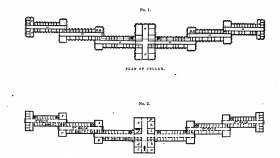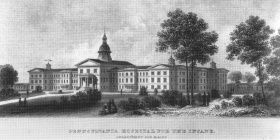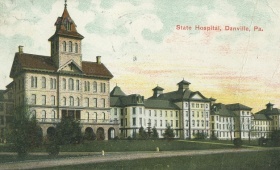Difference between revisions of "Kirkbride Planned Institutions"
M-Explorer (talk | contribs) m (adjusted image orders from rows of four to rows of two for lower resolution monitors) |
|||
| Line 25: | Line 25: | ||
| [[File:Original Kirkbride Plan 1854.jpg|thumb|280px|]] | | [[File:Original Kirkbride Plan 1854.jpg|thumb|280px|]] | ||
| [[File:Weston01.jpg|thumb|280px|[[Weston State Hospital]]]] | | [[File:Weston01.jpg|thumb|280px|[[Weston State Hospital]]]] | ||
| + | |} | ||
| + | {| | ||
| [[File:Trenton State Hospital NH003.jpg|thumb|280px|[[Trenton State Hospital]]]] | | [[File:Trenton State Hospital NH003.jpg|thumb|280px|[[Trenton State Hospital]]]] | ||
| [[File:HSH Kirkbride Color 1855.jpg|thumb|280px|[[Harrisburg State Hospital]]]] | | [[File:HSH Kirkbride Color 1855.jpg|thumb|280px|[[Harrisburg State Hospital]]]] | ||
| Line 36: | Line 38: | ||
| [[File:IPH MaleBldg 02.jpg|thumb|280px|[[Institute of the Pennsylvania Hospital]]]] | | [[File:IPH MaleBldg 02.jpg|thumb|280px|[[Institute of the Pennsylvania Hospital]]]] | ||
| [[File:Taunton 1854.jpg|thumb|280px|[[Taunton State Hospital]]]] | | [[File:Taunton 1854.jpg|thumb|280px|[[Taunton State Hospital]]]] | ||
| + | |} | ||
| + | {| | ||
| [[File:Dayton current.jpg|thumb|280px|[[Dayton State Hospital]]]] | | [[File:Dayton current.jpg|thumb|280px|[[Dayton State Hospital]]]] | ||
| [[File:Dixmont Map 02.jpg|thumb|280px|[[Dixmont State Hospital]]]] | | [[File:Dixmont Map 02.jpg|thumb|280px|[[Dixmont State Hospital]]]] | ||
| Line 55: | Line 59: | ||
| [[File:Improved Kirkbride Plan.jpg|thumb|280px|[Improved Kirkbride plan layout]]] | | [[File:Improved Kirkbride Plan.jpg|thumb|280px|[Improved Kirkbride plan layout]]] | ||
| [[File:Pont2.jpg|thumb|280px|[[Pontiac State Hospital Image Gallery]]]] | | [[File:Pont2.jpg|thumb|280px|[[Pontiac State Hospital Image Gallery]]]] | ||
| + | |} | ||
| + | {| | ||
| [[File:Spring Grove Thumb.jpg|thumb|280px|[[Spring Grove State Hospital]]]] | | [[File:Spring Grove Thumb.jpg|thumb|280px|[[Spring Grove State Hospital]]]] | ||
| [[File:Danville PC 08.jpg|thumb|280px|[[Danville State Hospital]]]] | | [[File:Danville PC 08.jpg|thumb|280px|[[Danville State Hospital]]]] | ||
| Line 76: | Line 82: | ||
| [[File:Cherokee1899.jpg|thumb|280px|[[Cherokee State Hospital]]]] | | [[File:Cherokee1899.jpg|thumb|280px|[[Cherokee State Hospital]]]] | ||
| [[File:Danvers.png|thumb|280px|[[Danvers State Hospital ]]]] | | [[File:Danvers.png|thumb|280px|[[Danvers State Hospital ]]]] | ||
| + | |} | ||
| + | {| | ||
| [[File:Topeka Kirk.jpg|thumb|280px|[[Topeka State Hospital]]]] | | [[File:Topeka Kirk.jpg|thumb|280px|[[Topeka State Hospital]]]] | ||
| [[File:Buffalo SH Aerial.jpg|thumb|280px|[[Buffalo State Hospital]]]] | | [[File:Buffalo SH Aerial.jpg|thumb|280px|[[Buffalo State Hospital]]]] | ||
Revision as of 08:35, 28 September 2011
The Kirkbride Plan is a 19th century building style that is the direct result of Dr. Thomas Story Kirkbride. Early in his career as superintendent of the Institute of the Pennsylvania Hospital he wrote a book titled: On the Construction, Organization and General Arrangements of Hospitals for the Insane. Within his book he espoused an architectural design for the hospital, administration of said asylum, placement of the hospital, and how the hospital grounds should be created and maintained.
A Kirkbride Plan building consists of a center section for the hospital administration and (in the early days) a living area for the superintendant and his family. Behind and to either side of the administration section are "wings" that contain patient wards. The patient wards staggered out and back from the administration section. From the air the building would look like a "V" or a "bat wing". Chapels, auditoriums, libraries, and kitchens were often built directly onto the rear of the administration section as this was a convenient, central location for these facilities since the male and female patients resided on opposite sides of the building. The Kirkbride Plan allowed for many other advantages over previous building styles. It allowed for maximum amounts of light and ventilation into the patient wards. It allowed for easier arranging of patients by type, typically the noisier and more uncontrollable patients were placed in the wards farthest from the administration section. It also allowed for easy expansion of the hospital, additional wards could be built onto the ends of the existing building without disrupting daily life at the hospital. Kirkbride Plan buildings tended to become large, imposing, Victorian-era institutions, between 3-5 stories tall, built on large extensively manicured grounds which often included farmland.
Completed in 1854, the Taunton State Hospital in Massachusetts became the first hospital built following the kirkbride plan. The slow demise of these institutions came about with a combination of the death of Dr. Kirkbride in the late 1880's and a shift in popular treatment methods for the insane. Around 1900 most new hospitals were moving away from the Kirkbride Plan in favor of smaller and more segregated styles of asylum construction. Many kirkbride buildings were lost in the 20th century due to fires, others were abandoned or demolished when newer buildings were constructed. Some have been modified so heavily that they no longer look like a kirkbride building. There are however, still a few Kirkbride buildings that have survived into the 21st century, some are still being used for their original purpose, others have been renovated for other uses like residential housing.
There are two types of Kirkbride Plan hospitals as specified by Dr. Kirkbride, his original and what he called the "improved plan". Later there was also a third class of "modified kirkbride" featuring semi detached wings rather than one continuous structure. Below are some key features and examples of each type.
Original Kirkbride
- Proper ventilation and design in accordance to the original building plan by Dr. Thomas Kirkbride
- Tightly grouped wards.
- No exterior porches.
- Influenced by AMASII patient limitations of only 250 patients.
- Continuous foundation and roof line.
- Shallow V design of structure
- Influenced by AMASII patient limitations of only 250 patients.
The original kirbride plan linear buildings were laid out in Kirkbride's 1854 "On the construction, organization, and general arrangements of hospitals for the insane". The hospitals built on this plan usually make a very shallow V, with the wards being only slightly set back. In the original plan by kirkbride the read rooms of the previous ward were in line with the front rooms of the following ward. Very few hospitals were built in line with this plan as very early kirkbrides began adopting elements of the imporved plan. The distinguishing feature of this plan is the very close proximity of the wards and usual lack or central alcove and bay window at wards end.
Some of these early kirkbrides were built with wards meeting at right angles taking a general U shape. Such as at the Institute of the Pennsylvania Hospital or Taunton State Hospital. Two hospitals, Dayton State Hospital and Dixmont State Hospital opted for a swept forward outter ward in each wing. Modifications such as this were generally made to accommodate for local topography.
Improved Kirkbride
- Further spacing between wards.
- Continuous foundation and roof line.
- Deeper V shape of structure
- Alcoves at ward center, usually with bay windows.
- Bay windows at end of each wards hallway
The improved kirkbride plan was described in the 1880 edition of Kirkbride's book, which included his new ideas on hospital construction since the 1854 edition was printed. Though this was published in 1880, the improved plan really originated with St. Elizabeth's hospital, which provided for further recessed wings for greater ward separation. According to Kirkbride the improved plan places more feet between the wards, giving room for a fireproof staircase and giving greater separation between the wards. Bay windows are also specified for the ends of each wards hallway and alcoves are specified for the ward centers. The locating of service buildings centrally behind the administration is also part of the improved plan. The distinguishing feature of this plan is the greater separation of each ward and central alcoves.
Modified Kirkbride
- Wards are more spaced out and may be connected by single or multistory hallways.
- Buildings often very ornate.
- Buildings are generally larger and can hold up to 600 patients due to changes by the AMASII in 1866.
- Buildings don't conform completely to the building plans specified by Dr. Thomas Kirkbride.
- Wards may take a T shape, rather than the traditional linear block ward.
Modified kirkbrides consist of detached but closely placed ward buildings laid out in the traditional kirkbride V pattern and connected via multi-storied hallways. The connecting corridors vary in length from short at Danvers State Hospital, to the longer curved hallways at Buffalo State Hospital. As these type of kirkbrdes were bult towards the later 1800s in the Victorian era the buildings are often very ornate. These buildings distinguishing feature is that they are separated ward blocks connected via stand alone hallways.














